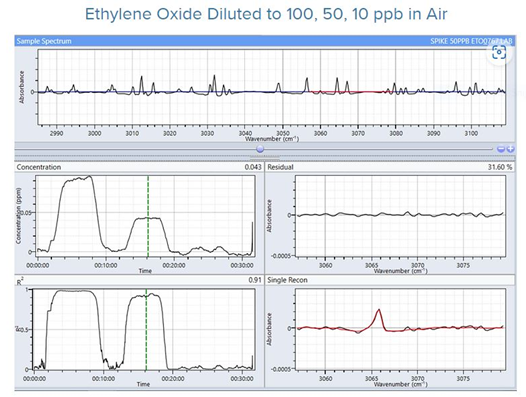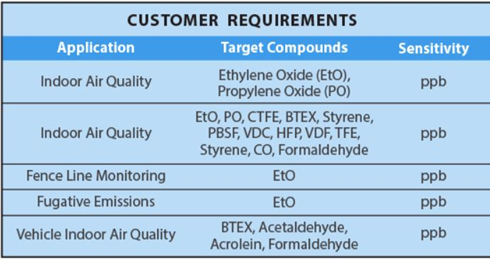Hazardous air pollutants, compounds known to cause cancer and other severe health issues, can present significant worker safety concerns for industries involved in using or producing chemical and petrochemical products.
The scope of the monitoring requirement extends widely and frequently encompasses sectors such as automotive, medical sterilization, agriculture, chemical manufacturing, semiconductors, and pharmaceuticals, among others.
Numerous industrial facilities employ various gas analyzer technologies to monitor hazardous air pollutants, whose levels are frequently regulated down to parts per million (ppm) due to the long-term health risks associated with exposure.
With the availability of more health data, these regulated exposure limits continue to decrease, leading to the need for monitoring at the parts-per-billion (ppb) level.
Limited technologies can meet this demand, particularly when considering the natural presence of ambient air moisture and other chemical compounds. These factors obscure the intended measurement and can generate false positives, proving catastrophic in a factory setting.
For instance, consider ethylene oxide (EtO), a colorless gas at room temperature, extensively employed as a medical equipment and cosmetics sterilizing agent. It also finds application in producing various products, including antifreeze, pharmaceuticals, and detergents.
EtO, classified as a highly toxic carcinogen, has recently garnered increased attention due to new regulations mandating emission monitoring down to single-digit parts per billion.
Given that EtO can be easily masked by elevated air moisture levels, obtaining swift and precise measurements in real-world environments can be challenging, even when dealing with ppm levels.
Manufacturers of EtO face an additional hurdle: the considerably less toxic chemical, ethylene, from which EtO derives, can readily generate false EtO readings, potentially leading to the shutdown of an entire facility.
Below are five recommendations for selecting a trace gas analyzer system that can effectively address the challenges posed by real-world factory environments.
1. Make Sure Your Technology Works in the Factory and Not Just in the Laboratory.
Gas chromatography (GC) has traditionally served as laboratory chemists' primary gas analysis tool. However, GC presents several notable limitations.
The most obvious is the considerable time required for a single measurement. In a factory setting, it is imperative to promptly identify upsets as they occur. With a typical measurement time of 10 to 15 minutes for trace gases, gas chromatography not only tends to underestimate the severity of an event but can also fail to detect it entirely.
This issue becomes particularly evident when multiple sample points are multiplexed through the same instrument, potentially resulting in hours passing before high-level emissions are accurately identified.
GC can be susceptible to false detections when closely related compounds are present. False alarms, such as the erroneous detection of a hazardous compound like EtO, may necessitate employees remaining in the shelter for extended periods while awaiting confirmation of a false positive.
Fortunately, these limitations of GC can be alleviated by utilizing optical-based technologies with near real-time capabilities. One such technology is Fourier transform infrared (FTIR) spectroscopy.
With measurement times of just a few minutes or less, FTIR and its newer counterpart, optically enhanced FTIR (OE-FTIR), not only offer swifter results but also demonstrate increased resistance to deception.
This enhanced performance stems from the broad spectrum coverage of FTIR, enabling the simultaneous identification of multiple compound spectral lines, thereby substantially improving detection accuracy even in the presence of interfering compounds.

Image Credit: Thermo Fisher Scientific – Environmental and Process Monitoring Instruments
The most advanced gas analyzers employ optically enhanced FTIR (OE-FTIR) spectroscopy, which can detect harmful air pollutants like ethylene oxide down to parts-per-billion and even parts-per-trillion levels.
2. Ensure Your Gas Analyzer Is Sensitive Enough to Measure Compounds at Levels Below the Permissible Exposure Permit.
Although FTIR has consistently delivered speedy and qualitative results, it has historically lacked the capability for low-level quantitative measurements. However, in recent years, FTIR has experienced significant technological advancement with the advent of optically enhanced FTIR, or OE-FTIR.
This technology now routinely achieves detection limits in the single-digit parts per billion (ppb) range and, in some instances, parts per trillion (ppt).
This enables measurements well below the regulated exposure limits, instilling greater confidence in accuracy and precision. It also offers the typical advantages associated with FTIR, such as speed, resilience to interferants, and the unique benefit of not requiring calibration.
Both OE-FTIR and FTIR come completely factory-calibrated, eliminating the need for field calibration, a significant factor in reducing total operating costs and enhancing the instrument's ease of use.
Source: Thermo Fisher Scientific – Environmental and Process Monitoring Instruments

In today's context, the permissible exposure limit for many harmful air pollutants is set at parts-per-billion concentrations.
3. Get a System Capable of Measuring Many Different Classes of Compounds at One Time.
In the discussion of GC technology, the emphasis was on the speed of compound measurement. Now, consider a scenario where the measurement of five or even a hundred compounds is required simultaneously, without prior knowledge of their composition.
Comparable to a vigilant sentry at the gate, FTIR and OE-FTIR continuously capture a broad spectrum of data stored at brief intervals. This data can be utilized to assess multiple compounds without any compromise in speed.
The need to revisit the past and search for compounds not initially suspected to be present poses no challenge; the data can be effortlessly reprocessed for any compound contained within the extensive library.
FTIR's capacity for multi-compound analysis and forensic applications sets it apart from other available analytical technologies.
4. Purchase a Solution, Not a Bunch of Components.
To this point, the focus has been on analyzer technologies. However, robust trace measurements, particularly in ambient air, require more than merely selecting an analyzer technology. While the choice of analyzer technology is undoubtedly crucial, it only constitutes half of the equation.
The equilibrium hinges on five other vital factors: sampling, conditioning, automation, data input/output, and integration. Each aspect is briefly outlined below.
Sampling involves more than merely drawing in ambient air; sampling systems often necessitate thermal control throughout their entire path to prevent compounds of interest from adhering to their surfaces.
The sampling system should encompass numerous individual channels to expand the sampling area, all while avoiding the need for multiple systems that inflate deployment costs. This objective is attainable only if the individual sample duration remains short, as previously discussed.
Conditioning the sample involves the use of technologies such as thermal oxidizers and auto reference algorithms.
These technologies can effectively eliminate the impact of changing ambient air conditions, which might otherwise lead to measurement drift over time. In environments with fluctuating humidity levels, such control becomes an absolute necessity.
Most ambient air systems are expected to operate continuously. Consequently, seamless automation makes the distinction between instruments that demand daily attention and those capable of operating autonomously for extended periods.
This automation should also exhibit flexibility, allowing adjustments not only to the compounds of interest but also to how these compounds are sampled, reported, and alarmed when they fall outside the designated range. The key here is flexibility tailored for industrial settings rather than laboratory environments.
Factory analyzers seldom function in isolation; they must be integrated into control rooms and data capture systems employing recognized industrial protocols. Even the most capable analytical system serves no purpose if it cannot meet reporting requirements.
Procuring a purpose-built integrated system is the key to long-term user satisfaction and the attainment of reliable measurements. Just as one would not construct an automobile by purchasing individual components, analytical systems designed for low-level trace compound measurement must be conceived as a unified system.
5. Make Sure Your Instrument Supplier Can Provide More Than Equipment
Behind every exceptional analytical instrument, there are analytical chemists, application engineers, and service personnel armed with profound real-world knowledge. The equipment provider should be equipped to assist with compound-specific methods, secure area deployment, and data validation.
Comprehensive training, service, and post-sale support should encompass analytical assistance, as real-world environments can occasionally yield unexpected results requiring data validation.
By selecting the appropriate trace gas analyzer system, companies can confidently safeguard their workforce while simultaneously reducing the overall cost of ownership when transitioning from older GC equipment to modern technologies like OE-FTIR.
With the right equipment, users should anticipate years of trouble-free service and technology capable of adapting to future requirements.

This information has been sourced, reviewed and adapted from materials provided by Thermo Fisher Scientific – Environmental and Process Monitoring Instruments.
For more information on this source, please visit Thermo Fisher Scientific – Environmental and Process Monitoring Instruments.